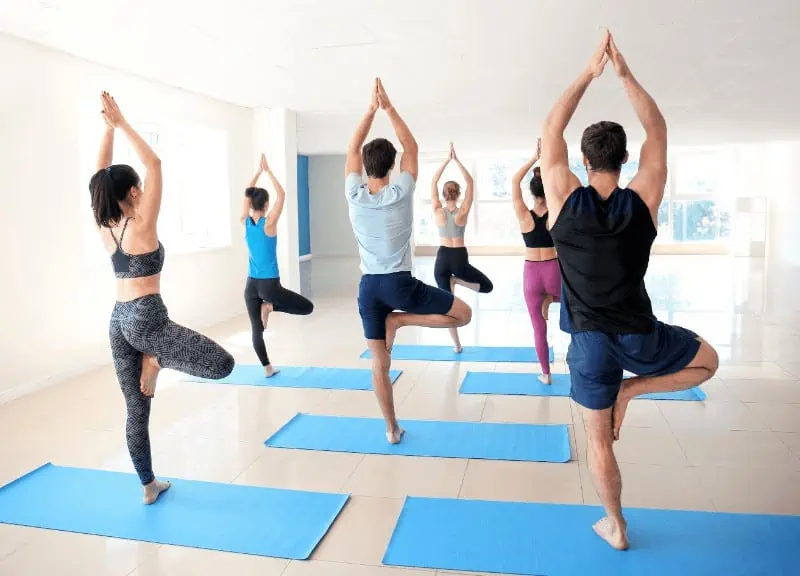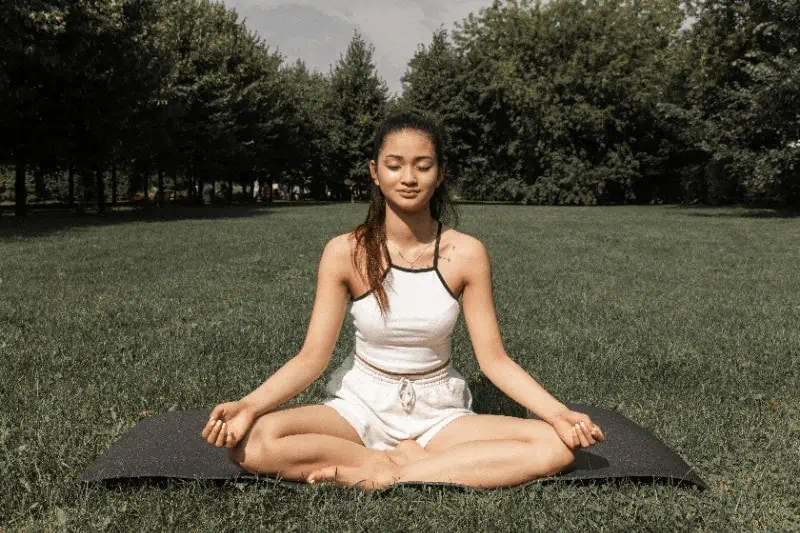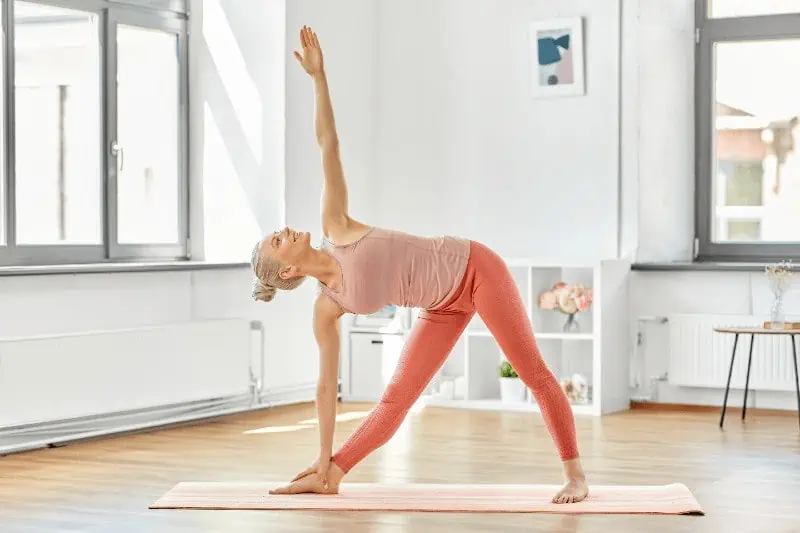With so many different types of yoga classes to choose from these days, how do you know which one is right for you? Have you ever browsed a yoga studio’s class schedule and wondered, “What is Hatha Yoga?” And what sets it apart from other forms of yoga?
In the yoga world today, “haṭha” is an umbrella term that includes many popular styles of yoga. Vinyasa, Ashtanga, Yin, Bikram, and Iyengar yoga all fall under the general category of Hatha Yoga. I like to use the analogy of how a square may be a rectangle, but not all rectangles are squares — most styles of yoga practiced in the West are Hatha, but that does not mean all Hatha yoga is the same!
While this variety in practices is great, it can also leave students a little bit confused as to what to expect from a Haṭha Yoga class. As a yoga teacher, how I approach guiding a Hatha class may differ in pacing, style, or poses from my colleagues. However, you’ll find certain principles of a Hatha yoga class remain consistent across this diverse yoga style.
This guide will take you through some of these critical aspects of the practice to set you up for success in multiple styles of Hatha yoga classes! By the end of this article, you’ll have a variety of answers to the question, “What is Hatha Yoga?” — from a historical, modern, and practical perspective.
So, are you ready, yogis? Let’s dive into the world of Hatha Yoga, starting from the beginning and focusing on the essential elements.
Contents
- 1 Defining: What is Hatha Yoga?
- 2 Hatha Yoga’s Origins and Historical Transition
- 3 Differentiating Hatha from Other Yoga Styles
- 4 What to Expect in a Hatha Yoga Class
- 5 Health Benefits of Hatha Yoga
- 6 Concluding Thoughts on Hatha Yoga
- 6.1 FAQ 1: What are the basic poses in Hatha Yoga?
- 6.2 FAQ 2: Can beginners do Hatha Yoga?
- 6.3 FAQ 3: How often should I practice Hatha Yoga?
- 6.4 FAQ 4: How does Hatha Yoga improve mental health?
- 6.5 FAQ 5: Is special equipment required for practicing Hatha Yoga?
- 6.6 FAQ 6: Can I practice Hatha Yoga at home?
- 6.7 Was this helpful?
Defining: What is Hatha Yoga?
Classical haṭha yoga originated in ancient India and today serves as a foundational cornerstone for many other styles of yoga. The critical elements of a Hatha yoga session include asana (physical postures), pranayama (breathing exercises), and meditation. The pranayama and meditation practices may often be enhanced with mudras (sacred hand gestures) and mantras (sacred chants).
Combining these principles creates a holistic experience and contributes to overall well-being — body, mind, and spirit.
Breaking Down the Name: What “Ha-tha” Means
When broken down, the term “haṭha” in Sanskrit translates to ‘ha’ (sun) and ‘tha’ (moon), symbolizing the balance of opposing energies within us. Alternatively, another translation of the Sanskrit word “haṭha” is “force,” signifying control over the flow of vital life force energy or prana .
No matter which definition of “haṭha” you take — balancing or controlling energy within the body — the same methods are applied: asana, pranayama, and meditation.
So, it’s safe to expect that a typical haṭha yoga class may include everything from asanas (poses) and pranayama (breath control) to meditation, mudras, and chanting mantras. These may seem like foreign concepts to someone new to yoga who may be thinking they’re showing up to a stretching class.
But that’s precisely what I feel makes Hatha Yoga such a wonderful practice: it can be a gentle introduction to yoga’s more spiritual and energetic side rather than just another form of physical workout!
Now that you know what “haṭha” means, let’s look at the origins of classical hatha yoga and examine how it rose in popularity over the years.
Hatha Yoga’s Origins and Historical Transition
To answer the question of what is hatha yoga requires a look back into history. The physical form of Hatha yoga originated in India around the 15th century CE.
The yogis who first practiced haṭha in ancient India were ascetics who used this form of yoga as a stepping stone to higher states of consciousness. The Hatha Yoga Pradipika, one of the classic texts on Hatha Yoga written by Swami Svatmarama, details 15 haṭha yoga poses intended initially to prepare the body for sitting in meditation.
In the late 19th century CE, an Indian guru named Swami Vivekananda introduced Hatha Yoga to the Western world, calling the practice the “science of the mind.” He traveled throughout the United States, giving lectures and demonstrations, contributing significantly to the popularity of yoga in the West.
Throughout the 20th century CE, the haṭha style began to expand and change to fit the needs of a modern, active community of yogis, eventually branching out into the different types of Hatha Yoga we recognize today.
Evolution from Spiritual Practice to Physical Workout
Haṭha yoga was not always so body-focused. The original intention practice had a spiritual purpose, using asanas, pranayama, and mudras to achieve deeper states of meditation. It involved rituals, studying ancient texts, and sectarian initiations between a guru (teacher) and a student.
The practices associated with Hatha Yoga, including pranayama and asana, controlled the vital energy flow of prana in the body to bring a state of equilibrium and achieve enlightenment. Over time, physical postures or asanas became more prominent as more and more poses were added to the Hatha Yoga repertoire.
Western Influence on Hatha Yoga
Western culture played a significant role in modifying Haṭha Yoga, leading to different types of practice, such as Ashtanga and Vinyasa Yoga. For this reason, Haṭha Yoga as we know it today owes much to the West for popularizing this ancient practice.
- This shift occurred during the 20th century CE with renowned teachers like Pattabhi Jois, the founder of Ashtanga Yoga, and B.K.S. Iyengar.
- Westerners interested in keeping fit began practicing haṭha and vinyasa yoga, recognizing their health benefits rather than their spiritual aspects.
- Modern teachers like Ana Forrest and Baron Baptiste emerged, adapting the traditional teachings of Haṭha Yoga to meet the needs of a modern, active community of yogis with new, popular styles of yoga.
From Asceticism to Wellness and Fitness
From ancient texts to modern times, the principles of classical haṭha yoga have evolved over the years to be easily applied to the lives of everyday people, not just ascetics and monks.
Haṭha Yoga scholar and expert James Mallison speaks to this in his analysis of the practice’s popularity in the modern era, stating that the Haṭha movement broadened access to yoga worldwide, removing the need for “ascetic renunciation or priestly intermediaries, ritual paraphernalia, and sectarian initiations.”
In fact, the accessibility of haṭha yoga drew me to the practice when I was first starting my yoga journey, as I’m sure is true for many others. While other forms of fitness often seem like joining an exclusive group, haṭha yoga is available for all types of people to try.
Today, when asked what is hatha yoga, we can describe modern haṭha yoga as rooted in ancient traditions while also focusing on improving strength, flexibility, and mental well-being. The popularity of haṭha yoga in various forms has skyrocketed due to this new focus on physical health while still honoring the original practices detailed in the classic texts.
Differentiating Hatha from Other Yoga Styles
You might remember from the introduction of this article that most modern styles of yoga practiced today are offshoots of Haṭha Yoga. Although Vinyasa, Yin, Ashtanga, and many others come from the same source, they differ significantly in movement style and intention.
So, let’s take a closer look at what is hatha yoga exactly and explore how it differs from its various modern-day branches.

Emphasis on Balance
Traditional hatha yoga practices are unique because they emphasize balance between body and mind, unlike other styles that focus more on physical strength. The name demonstrates this central theme: ha (sun) and tha (moon) exist in equilibrium.
The aim is to achieve perfect harmony between one’s physical and mental state through hatha yoga practices. This includes external exercises like asanas (poses) and internal means, using pranayama to control breath flow.
During a class, occasionally, I’ll ask my students what comes to mind when they think about the concept of “balance?” Is it just standing on one leg while holding a specific position? The principles of haṭha Yoga teach us that balance is a state of being, not just a performed action.
Slower Pace than Vinyasa or Ashtanga
Hatha yoga practices have a slower pace compared with more energetic styles. You might find haṭha a bit slow, especially if you’re familiar with other popular styles like Ashtanga, Power, or Vinyasa Yoga.
Typically, in a hatha yoga session, you’ll hold an asana for a couple of minutes rather than flowing from posture to posture. Moving slower and holding postures for more prolonged periods encourages mind-body connection, breath control, and relaxation.
Another significant advantage I see in this aspect is that the slower pace gives beginners the time to learn the correct alignment of postures they might otherwise muddle through in a more dynamic, quickly-moving style.
Less Emphasis on Perfecting Individual Poses
In traditional haṭha, the focus is more on your holistic well-being rather than mastering individual postures. Of course, alignment and safety are always a priority in any yoga class, and Haṭha Yoga certainly encourages optimum posture and body awareness.
However, it is less structured than Ashtanga Yoga, which emphasizes progressing through a series of postures systematically. In a flow-style class, each asana builds on the one before it, creating the need for more expertise to keep up.
During a haṭha yoga class, you’ll spend plenty of time in each position rather than rush through a sequence. As a student, this allows you to worry a little bit less about what your physical body is doing, instead being able to pay attention to your vital energy, breath flow, and how each asana affects your overall experience.
What to Expect in a Hatha Yoga Class
If a prospective student completely new to the world of yoga asked me, “What is hatha yoga?” I would explain that most haṭha classes contain three main parts: asana (poses), pranayama (breathing), and meditation.

Basic Yoga Postures
Have you ever been to a hatha yoga class? You’ll likely notice the yoga teacher starts with basic haṭha postures or asanas. These poses are quite accessible and perfect for beginners.
Here are some of my favorite asanas to include in a beginner-friendly haṭha yoga session.
- Tree Pose (Vrksasana): builds balance, strength, and focus.
- Mountain Pose (Tadasana): brings awareness to posture and overall alignment.
- Easy Pose (Sukhasana): the most common position to practice seated meditation.
To try them out for yourself, follow the links for our in-depth pose guides!
Breathing Techniques
A traditional haṭha yoga session will typically proceed with pranayama or breathing exercises. Your yoga teacher will guide you through these techniques. Each type of pranayama has a specific use, from balancing vital energy to calming the nervous system or cooling the body.
When introducing new students to these breathing techniques, I prefer to start with Kumbhaka pranayama. Here’s how to do it:
- Sit comfortably with your back straight (use any props necessary, such as a meditation cushion).
- Close your eyes and release tension from your neck and shoulders, letting your body relax.
- Inhale through your nose, filling your lungs with air.
- At the top of your inhale, hold your breath. Retain the air in your lungs for a count of 5 seconds.
- Exhale slowly through your nose until your lungs are empty. Then, begin your next inhale.
- Repeat this pattern for 3 to 5 minutes. Try to gradually increase the duration of breath retention as you become more comfortable with the practice.
- Finish your session by taking a few normal breaths and slowly opening your eyes.
Breathing exercises are central to many different yoga practices. To learn more about pranayama and various techniques, visit our guide here!
Relaxation and Meditation Periods
Finally, at the end of every haṭha yoga class is a period of relaxation and meditation. This is arguably the most essential part of a yoga session. This quiet time of introspection allows your mind and body to integrate and absorb all the benefits of your practice.
Usually, you’ll finish your haṭha class in Savasana or Corpse Pose, lying flat on your back with your eyes closed. You may be offered props like bolsters or blankets to ensure maximum comfort and relaxation.
During this time, your teacher may lead you on a guided meditation, use chimes or singing bowls, or simply hold space quietly for self-reflection.
Health Benefits of Hatha Yoga
Haṭha yoga practices, as described in ancient texts, offer numerous benefits for both the body and mind. Let’s explore how these ancient principles can improve your modern-day life.
Enhanced Flexibility, Strength, and Balance
Haṭha yoga postures work on your physical body to stretch and strengthen muscles. For example:
- Warrior pose, a common asana in haṭha yoga, builds leg strength and ankle stability while lengthening the inner thigh.
- Locust pose, another asana you’ll likely encounter in a haṭha practice, improves posture and strengthens the entire back body.
Greater Mental Clarity and Inner Peace
Haṭha yoga offers a range of mental and spiritual benefits, making it a holistic practice for overall well-being. Here are some of its positive influences:
- It helps to reduce stress and anxiety, promoting a state of calm.
- Improves focus and concentration.
- Fosters self-awareness and mindfulness.
- Encourages a deeper connection with one’s inner self and the universe.
The practices outlined in the ancient texts of haṭha yoga are still relevant for today’s yogis who wish to improve their overall physical and mental health.
Concluding Thoughts on Hatha Yoga
With its rich history and unique approach detailed in various ancient texts, Haṭha yoga sets itself apart from other yoga styles. Its focus on balancing energies through physical postures and breath control offers a holistic experience catering to seasoned practitioners and people just beginning their yoga journey.
As outlined in ancient texts, the key poses in Haṭha yoga improve flexibility and contribute to overall health benefits, including stress reduction and improved concentration. Engaging in a regular Haṭha practice can be a transformative journey towards achieving balance and wellness.
So, to answer the main question — what is hatha yoga? — one could say it is a personal journey. If you’re just starting, remember there’s no rush in a haṭha session—take it one pose at a time. If you’ve considered trying yoga, I believe a haṭha class is the perfect place to start!
FAQ 1: What are the basic poses in Hatha Yoga?
Haṭha Yoga incorporates several basic poses such as Mountain Pose (Tadasana), Downward-facing Dog (Adho Mukha Svanasana), Warrior I & II (Virabhadrasana I & II), Corpse Pose (Savasana), and Child’s Pose (Balasana) among others. You’ll also find various postures for seated meditation included in the practice.
FAQ 2: Can beginners do Hatha Yoga?
Absolutely! In fact, I would specifically recommend Haṭha Yoga over other types of yoga for beginners due to its slower pace. This allows students to familiarize themselves with the foundational poses of yoga, allowing them to progress into other styles as they develop their knowledge.
FAQ 3: How often should I practice Hatha Yoga?
The frequency of your yoga practice can be adapted to your individual preference and schedule. However, consistency is vital in any exercise, including haṭha yoga. Regular practice will yield significant benefits over time, even if it’s just once or twice a week.
FAQ 4: How does Hatha Yoga improve mental health?
Haṭha Yoga involves mindful breathing techniques and meditation. These practices help reduce stress levels, increase focus, improve self-awareness, and promote better sleep quality.
FAQ 5: Is special equipment required for practicing Hatha Yoga?
While having a good quality non-slip mat (like one from Alo Yoga) is highly recommended for comfort and safety, you don’t necessarily need specialized equipment to practice Haṭha Yoga. Comfortable clothing that allows free movement is all you need to get started with yoga — stock your yoga wardrobe with Lululemon’s “We Made Too Much” sale!
FAQ 6: Can I practice Hatha Yoga at home?
Yes, it’s possible to practice Haṭha Yoga at home. Numerous online resources and video tutorials are available for beginners and experienced practitioners.


